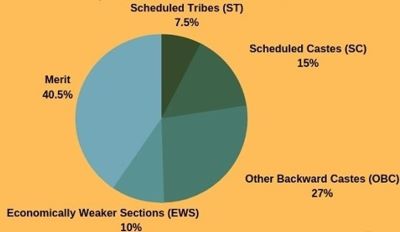Context:
The allotment of Indian Administrative Service (IAS) to Puja Khedkar as an Other Backward Class (OBC) Non-Creamy Layer (NCL) candidate coupled with multiple disabilities has raised issues surrounding the creamy layer in OBC reservation.
Historical Background of Reservations
Articles 15 and 16 of the Constitution
Articles 15 and 16 of the Indian Constitution guarantee equality to all citizens in government policies and public employment. To promote social justice, these articles allow special provisions for the advancement of socially and educationally backward classes, including OBCs, Scheduled Castes (SCs), and Scheduled Tribes (STs).
Implementation of Reservations
Reservations for SCs and STs are fixed at 15% and 7.5%, respectively, in central government jobs, educational institutions, and public sector undertakings (PSUs). In 1990, during V. P. Singh's tenure as Prime Minister, the Mandal Commission's recommendations led to the implementation of 27% reservation for OBCs in central government employment. The scope of reservations was further expanded in 2005 to include OBCs, SCs, and STs in educational institutions, including private ones. In 2019, a 10% reservation was introduced for Economically Weaker Sections (EWS) within the general category.
Understanding the Creamy Layer
Supreme Court Ruling in the Indra Sawhney Case
In the Indra Sawhney case (1992), the Supreme Court upheld the 27% reservation for OBCs but capped the total reservation at 50%, barring exceptional circumstances. The court mandated the exclusion of the creamy layer from OBC reservations to maintain the principle of equality.
Criteria for Exclusion
The criteria for identifying the creamy layer are based on the recommendations of the Justice Ram Nandan Prasad Committee (1993). The determination of creamy layer status is based on the income and position of an applicant’s parents. Specifically:
● Income Criteria: Parental income, excluding salary and agricultural income, must exceed ₹8 lakh annually for each of the last three financial years.
● Position Criteria: The creamy layer also includes applicants whose parents fall into one of the following categories:
○ Either parent entered government service (central or state) as a Group A/Class I officer, or both parents entered as Group B/Class II officers or the father was promoted to Group A/Class I before the age of 40.
○ Either parent is employed in a managerial position in PSUs.
○ Either parent holds a constitutional post.
Issues with the Current System
● Inadequacies in the Process
Recent controversies have highlighted several issues with the creamy layer criteria. There are allegations that some applicants obtain NCL or EWS certificates through dubious means, including the misuse of disability certificates to benefit from reserved quotas. Additionally, strategies such as asset gifting or premature retirement are reportedly used to circumvent creamy layer exclusion, as the income of the applicant's spouse is not considered.
● Concentration of Reservation Benefits
The Rohini Commission, set up to recommend sub-categorization among OBC castes, has estimated that 97% of reserved jobs and seats in educational institutions are held by just 25% of OBC castes/sub-castes at the central level. Nearly 1,000 of the approximately 2,600 OBC communities have zero representation in jobs and educational institutions. Similar issues of benefit concentration are noted in the SC and ST categories, which do not have creamy layer exclusions.
● Current Reservation Landscape
The total reservation, including for EWS, stands at 60%. Despite this, government responses in Parliament indicate that 40-50% of reserved seats for OBCs, SCs, and STs in central government positions remain unfilled.

Proposed Solutions for Equitable Distribution
● Addressing Loopholes
To address the issues with NCL, EWS, and disability certificates, thorough scrutiny is necessary to ensure that only eligible individuals receive these benefits. Implementing stricter verification processes can help prevent fraudulent acquisition of certificates.
● Filling Reserved Vacancies
It is crucial to fill reserved vacancies without backlog to ensure that the intended benefits reach deserving candidates. Addressing backlog issues can improve the effectiveness of the reservation system.
● Sub-Categorization and Creamy Layer Exclusion
Sub-categorization within reservations may be essential to address the under-representation or non-representation of various communities. Additionally, considering creamy layer exclusion in SC and ST categories, especially for children of Group I/Class A officials, could enhance equity. Engaging in discussions with stakeholders to explore and implement these proposals is important to ensure that the benefits of reservation reach the most marginalized among underprivileged communities.
Conclusion
The debate over reservations and the creamy layer underscores the need for a balanced and effective approach. While the reservation system has made significant strides in promoting social justice, reforms are necessary to address discrepancies and ensure that benefits are equitably distributed. Thoughtful adjustments and rigorous implementation will be crucial in achieving a fair and effective reservation system.
|
Probable Questions for UPSC Mains 1. Examine the judicial pronouncements on the creamy layer concept in OBC reservations, focusing on key cases such as Indira Sawhney v. Union of India, Ashok Kumar Thakur v. State of Bihar, and Jarnail Singh v. Lacchmi Narain Gupta. Discuss how these rulings have shaped the reservation policy and address the current challenges and criticisms related to creamy layer exclusion. (10 Marks, 150 Words) 2. Analyze the effectiveness of the current reservation system in addressing social and educational inequalities among OBCs, SCs, and STs. Consider the impact of the creamy layer exclusion and concentration of reservation benefits. Propose reforms to enhance the equitable distribution of reservation benefits and discuss the potential challenges in implementing these reforms. (15 Marks, 250 Words) |
Source: The Hindu









